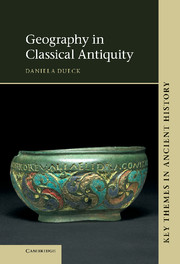Chapter 3 - Mathematical geography
Published online by Cambridge University Press: 05 June 2012
Summary
Shapes and sizes
Our mental image of the world is always based on a combination of actual geographical knowledge and imagination, that is, on a mix of directly experienced and abstractly conceived space. In antiquity, when remote regions were still inaccessible, legendary elements played a larger role. But after travel and conquest increased direct acquaintance with distant frontiers, solid facts based on autopsy began to support more accurate reports and theories.
Early notions of the world occasionally combined myths with real facts derived from experience. At the same time, in the Archaic period (seventh–sixth centuries bce) a rationalistic approach to understanding the universe and the world emerged. This tendency sought scientific explanations based on sensory assessment and logical inference, and produced the mathematical branch of geographical discussion. This approach continued to be practised thereafter throughout antiquity alongside the descriptive one. As was argued in chapter 2, the descriptive approach did not refrain from considering marvellous and paradoxical situations in a way contradictory to scientific thinking. But the factual foundation of both branches solidified with the growth in direct knowledge of remote regions.
- Type
- Chapter
- Information
- Geography in Classical Antiquity , pp. 68 - 98Publisher: Cambridge University PressPrint publication year: 2012



